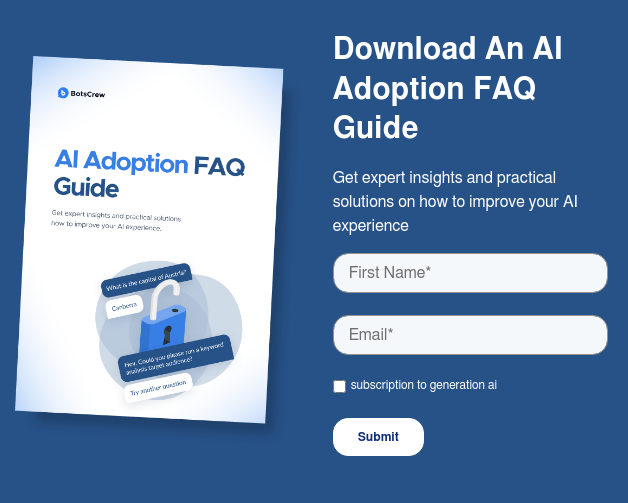The True Value of Generative AI: Measuring ROI, And Why It's Tricky
Enterprises are ready to pour more money into the gen AI pot, but figuring out the Generative AI ROI remains a challenge (however, it's far from mission impossible).

Generative AI has the power to supercharge a wide variety of business areas, making it a game-changer for nearly every function and team.In other words, everyone's potential benefits are on the table. That is why, according to a Deloitte report, 2 out of 3 organizations are doubling down on their investments in generative AI after spotting strong early returns.
Meanwhile, a 2024 KPMG survey reveals that 78% of senior business leaders are optimistic about seeing Gen AI ROI by 2027 at the latest.
However, when it comes to pinpointing whether financial and operational gains actually stem from these AI efforts, enterprises find themselves in murky waters. Even C-level specialists are scratching their heads when it comes to Generative AI ROI. In fact, Deloitte reports that about 41% of companies have struggled to measure the true impact of their AI initiatives.
This article is here to help you crack the code on just how much value AI can add to your company — and how to calculate its ROI. We'll guide business leaders through strategies to navigate this transformative technology and move beyond the buzz to uncover its actual impact.
Here is what we'll cover:
✅ Why measuring Generative AI ROI is both critical and yet tricky
✅ Proven strategies for calculating AI ROI tailored to your business needs
✅ How do we measure the Gen AI ROI for our clients and products.
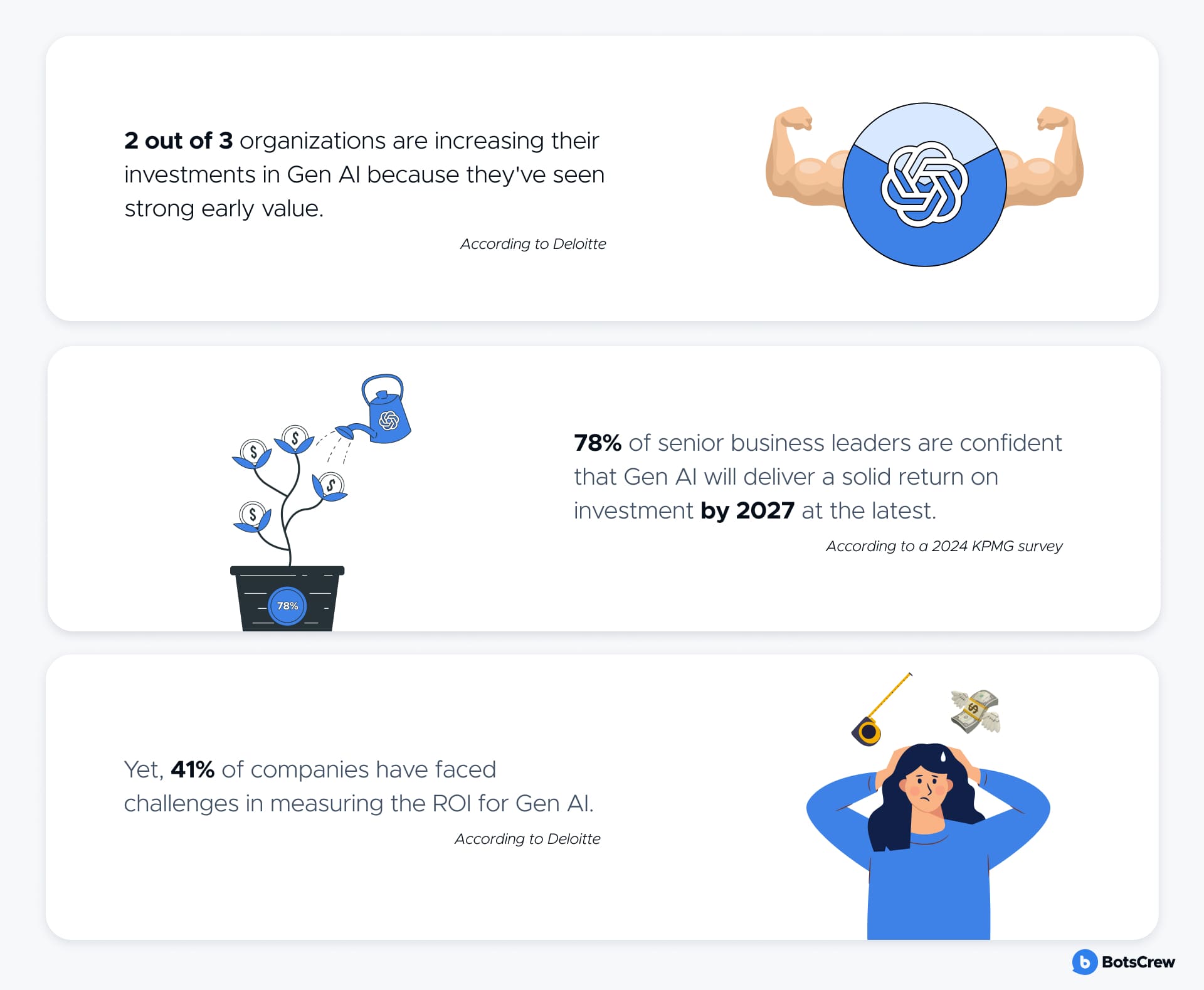
The Importance of Measuring Generative AI ROI
Measuring the Generative AI ROI is a must for businesses that want to play smart:
— Fine-Tune Your Tech. By pinpointing Gen AI's impact on specific operations, you can double down on what's working and tweak what is not.
— Seal the Deal on Funding. A rock-solid Generative AI ROI case is your ticket to budget approval. When you show decision-makers complex numbers, it's much easier to get the green light for new AI projects and the resources needed to keep them humming along.
— Set Benchmarks & Track Progress. Gen AI ROI metrics help you set performance baselines and track Generative AI's ongoing impact. Think of it as your performance dashboard which allows you to steer and adjust as business needs and market conditions shift.
— Show the Value & Build Trust. Clear, quantifiable results are gold for proving GenAI's business value. This transparency builds trust and earns buy-in across the company, driving broader adoption and boosting the overall impact.
Play your AI cards right, and you'll future-proof your business while staying miles ahead of the competition. Schedule a call with our experts, and we'll dive into your use case to identify what can be automated and how AI implementation can drive measurable ROI for your business.
Measuring Gen AI's Impact: Key Questions and Strategies for Every Leader
According to IDC's 2023 global study, for every $1 companies pour into AI, they are seeing an average return of $3.50. And 5% of organizations worldwide are cashing in more prominently, raking in an average of $8 for every dollar spent.
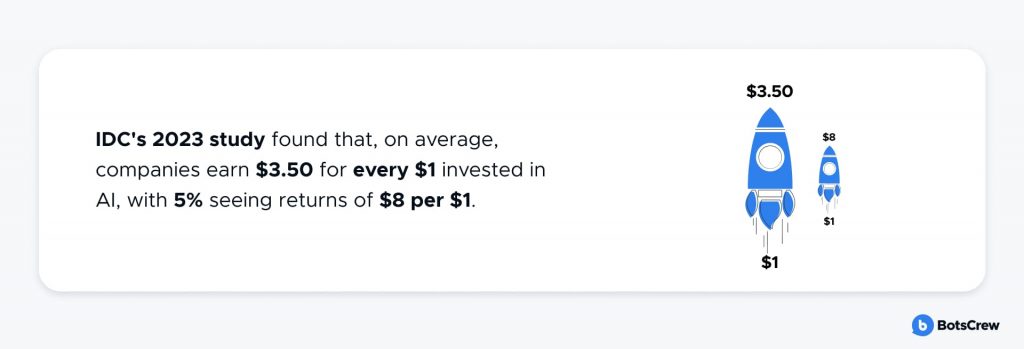
Okay, but how can organizations measure the return on investment (ROI) of Generative AI implementation?
Ask The Right Questions
Industry leaders should be asking themselves questions like:

These questions help pinpoint where AI is making an impact and where it's driving value for the business, laying the groundwork for calculating true ROI.
Keep In Mind Key Benchmarks
Gen AI ROI measurement strategies will differ across industries, and the KPMG survey highlights these differences:
- Healthcare and Life Sciences: 57% rely on document assessment tools.
- Industrial Markets: 64% use AI for inventory management.
- Tech, Media, and Telecommunications: 43% focus on workflow automation.
- Consumer and Retail: 19% highlight customer-facing chatbots.
Use The Gen AI ROI Formula
To calculate ROI, compare the cost of GenAI implementation to the benefits it brings. Formula with an example (for instance, if an enterprise spends $400,000 on an AI project and generates $600,000 in benefits, the ROI of Generative AI is):
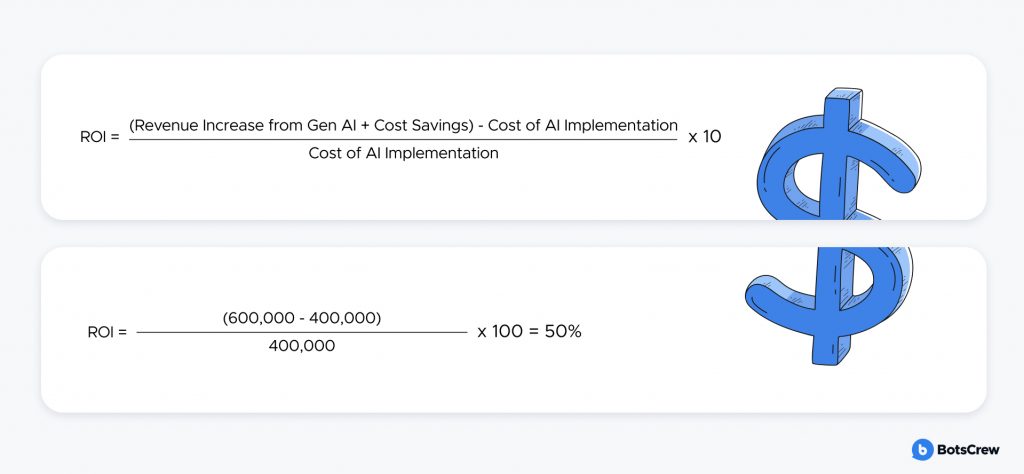
This means for every $1 invested, the company gets $1.50 in return (including cost savings and additional revenue).
Embrace a Multi-Metric Approach
Do not focus solely on financial numbers. Consider:
✅ Efficiency Gains: Track time saved through AI automation and quantify cost reductions.
✅ Employee Productivity: Measure how much more time employees can focus on strategic tasks thanks to AI.
✅ Innovation: While harder to track, note the number of AI-driven ideas adopted or new products/services developed because of generative AI.
Leverage A/B Testing (When Feasible)
When possible, A/B testing can isolate the impact of Generative AI. Compare a control group that doesn't use AI to a treatment group that does, allowing you to directly measure its effect. While not always applicable in every business context, it can be insightful in specific cases.
The standard practice is to have at least a 3:1 ratio of investment to return in the first year.
A general point or metric to consider is the level of automation. We assess the automation rate based on the specific use case and then use a more targeted metric to measure this overall.
For example, in customer service within a helpdesk, we would measure the automation rate as the percentage of total tickets that are fully handled by AI without human intervention. Separately, to assess ROI, we could track time saved per ticket, which directly translates into cost savings and efficiency gains.
In logistics customer service, say for a truck that’s had an accident, we could measure how many queries are resolved before the user escalates to management or service points. Depending on the degree of automation of human tasks, we could measure this in terms of hours saved or units of work completed. However, escalation rate can be measured across various industries to gauge AI's impact on customer service efficiency.
Another metric to consider is the additional revenue earned, potentially driven by the automation percentage.
Lastly, there is a more controversial method for measuring impact: calculating how many people it would take to do the same work if it were done by humans. This is measured in salaries. For instance, if AI automates 320 hours of work, that is roughly equivalent to two full-time employees. If those employees are based in the US, this could save approximately $200,000 annually. So, you can consider that AI has saved you $200,000.
Our Approach
We lay out the potential ROI of Generative AI in the proposal stage, but we typically do not measure it until at least after the first year. Jumping the gun doesn't make much sense: the first 3 months are spent mostly building the system, so it's not yet up and running and paying off. Once the system is live, you can't expect everything to be smooth sailing right after launching. There is usually a period of 1 to 3 months of learning from users and fine-tuning the system.
So, the objective evaluation comes a year after the solution is entirely in play. By then, there is enough data to see the real impact. But don't wait until the year-end — track at least one key metric every month to gauge how things are shaping up.
Take, for example, a project we worked on with a company in genetic testing and diagnostics. The key success metric was the number of tickets automated. To keep things on track, we touched base with the client every month to update them on the automation rate. By the end of the year, we had enough data — both quarterly and annually — to measure how much we saved.
After 3 years, we achieved 91% automation rate with the AI assistant. Without it, all of those tasks — like explaining genetic test results — would have been handled manually by genetic counselors.
Challenges in Measuring ROI of Generative AI
Calculating the return on investment (ROI) for artificial intelligence initiatives is more complex than you would think. According to Deloitte, around 41% of companies are struggling to determine whether their financial and operational improvements are actually coming from their AI initiatives. The main hurdles businesses face in measuring the ROI of Generative AI are:
Data complexity
An overwhelming amount of low-quality data undermines the integrity of AI results. To ensure your AI delivers the goods, it is essential to gather reliable, accurate, and accessible data — providing the solid foundation needed for effective training and optimal results.
💡 Solution: implement a data quality management strategy that emphasizes regular data cleaning, validation, and enrichment. Use AI data governance tools to identify inconsistencies and inaccuracies. Standardize data collection processes to ensure consistency across departments. This will help provide a reliable foundation for accurate AI outputs and measurable ROI.
Business environment changes
Unpredictable changes in internal and external business environments impact the relevancy of chosen metrics. For instance, the market itself shifted, and the company operates in an industry that is currently more in demand, bringing in more clients.
💡 Solution: develop flexible ROI measurement models that account for external and internal changes. Incorporate scenario analysis to understand how shifting conditions could impact metrics. Use rolling baselines that evolve as business conditions change, ensuring you continue to track ROI accurately even in dynamic environments.
The Challenge of Pinpointing AI Savings
It's challenging to pinpoint exactly where the savings from AI come from. For example, the company might have laid off some employees and hired more productive ones, which can skew the impact. Or launched a new marketing initiative, and the saved time didn't influence the final outcome that much. Or perhaps the company received additional investments and poured resources into a new product, which could have increased performance independently of AI.
💡 Solution: use A/B testing where feasible to isolate the impact of AI. Create a control group that doesn't experience AI-driven changes and compare it to a group that does. Break down ROI into smaller components to attribute specific improvements to AI, ensuring you have clarity on where the savings originate.
The Lack of Tracking Before AI Implementation
It's easier to measure if the company has already tracked metrics beforehand. If they didn't track the time spent on tasks before implementing AI, it is impossible to accurately say that the software has automated X hours of work.
💡 Solution: start by benchmarking current performance as early as possible. Use historical data to establish a proxy baseline where applicable. If historical data is unavailable, track performance from the point of AI implementation, and measure incremental improvements moving forward. This helps provide a starting line for future ROI calculations and continuous improvement tracking.
Best Practices for ROI-Positive Generative AI Adoption
Do not get lost in the hype, leaving teams overwhelmed and the ROI of Generative AI unclear. Without a strategic approach, businesses can quickly become overwhelmed and miss out on Gen AI's full value. Follow these best practices to ensure your AI adoption leads to measurable, positive ROI.
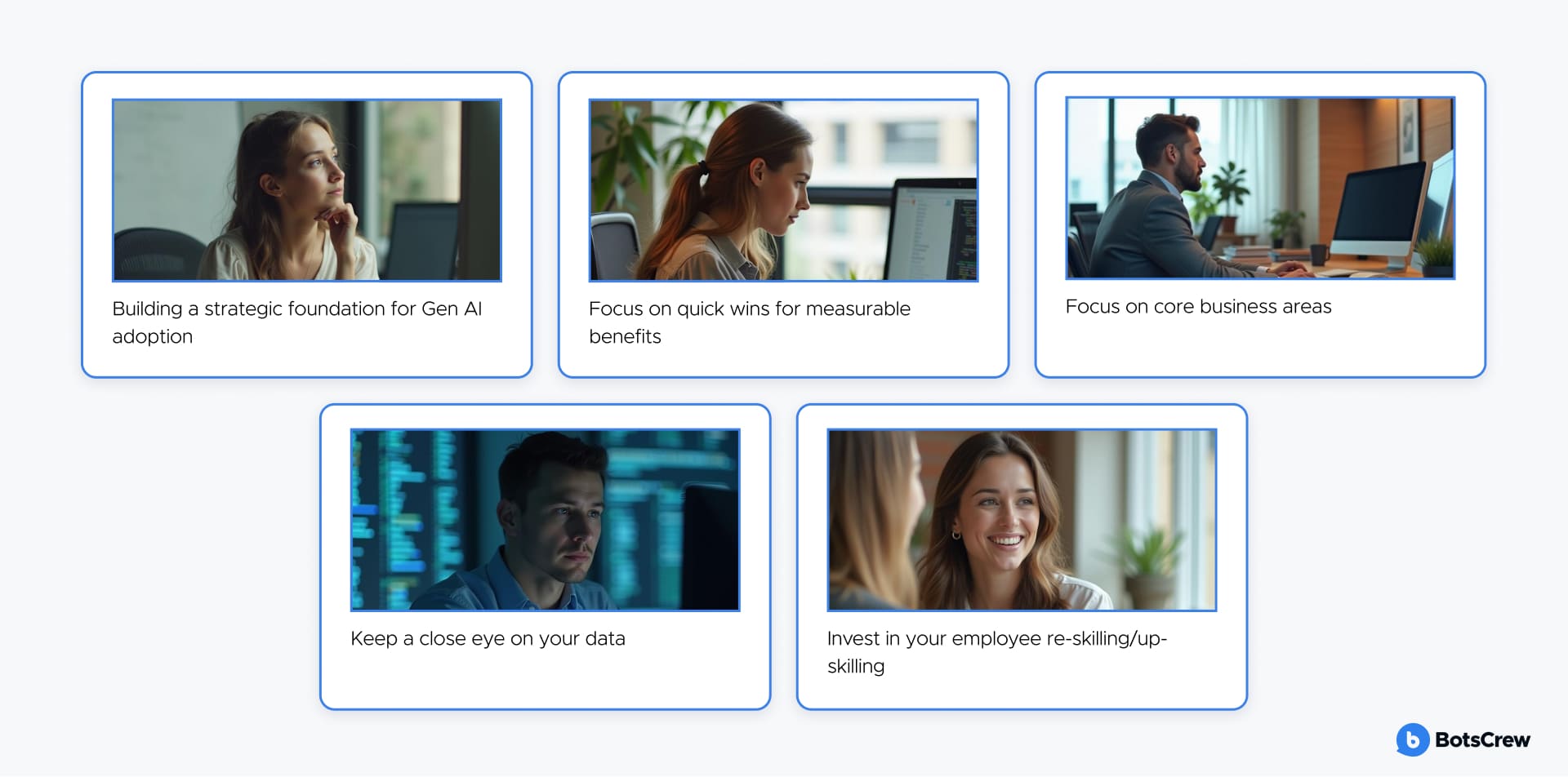
Build a Strategic Foundation for Gen AI Adoption
To achieve ROI, start with a clear vision that defines strategic goals, key use cases, and expected outcomes. Align these goals with your business priorities to ensure every initiative drives value. Secure buy-in from teams and appoint a senior leader to champion adoption, ensuring alignment and momentum throughout the organization.
Focus on Quick Wins for Measurable Benefits
Tackle use cases that are easy to implement, address immediate business needs, and deliver quick returns. Automating customer service tasks, streamlining employee workflows, or enhancing productivity are examples that can quickly demonstrate ROI and build momentum for further AI initiatives.
Focus on Core Business Areas
For maximum ROI, embed Gen AI into your core operations rather than treating it as a departmental experiment. Integrate AI in key functions like sales, marketing, and customer support to amplify its impact and boost enterprise-wide efficiency and profitability.
Keep a Close Eye on Your Data
Accurate, clean, and accessible data is the fuel for ROI-positive AI outcomes. Capitalize on existing enterprise data to train models effectively and ensure consistent output. Regularly invest in data infrastructure to avoid AI performance drops and maintain the integrity of AI-driven decisions.
Invest in Your Employee Re-skilling/Up-skilling
ROI doesn't just come from technology — it comes from your people. Upskilling employees in AI technologies ensures they can deploy, manage, and/or maximize Gen AI solutions.
Maximize Generative AI ROI with BotsCrew Services






